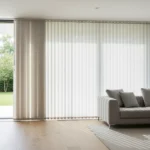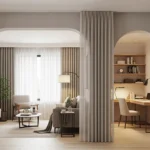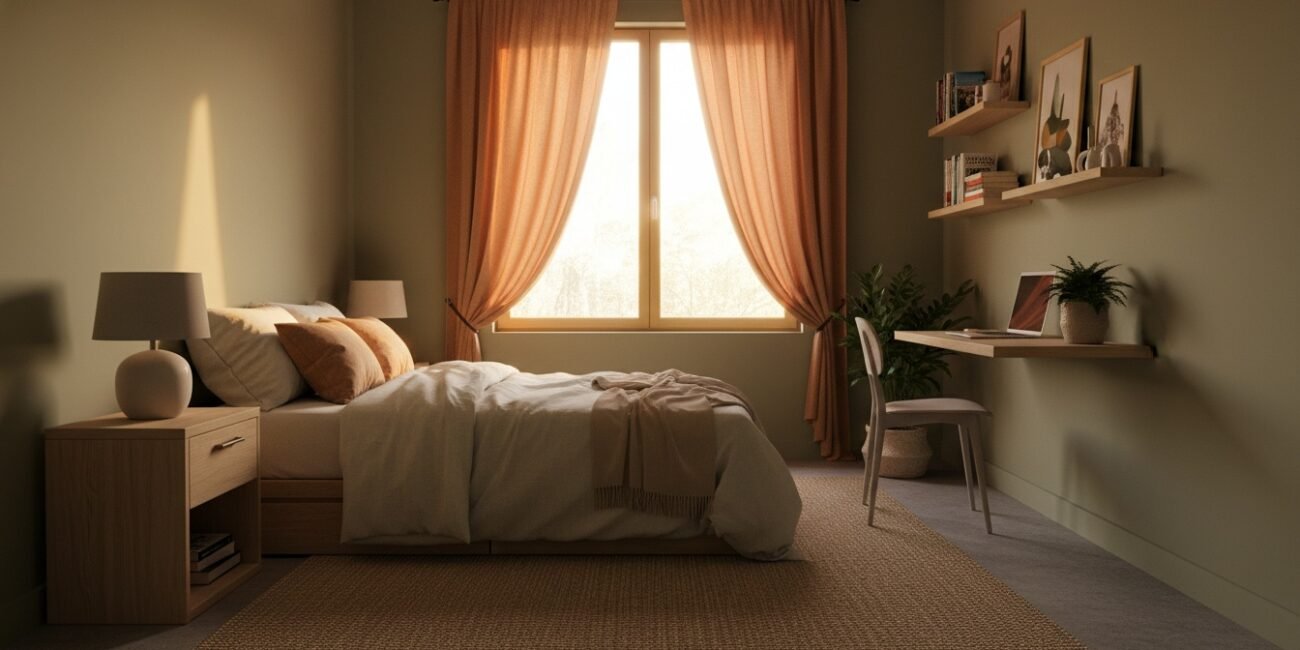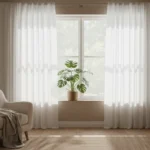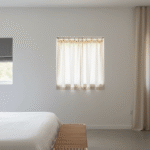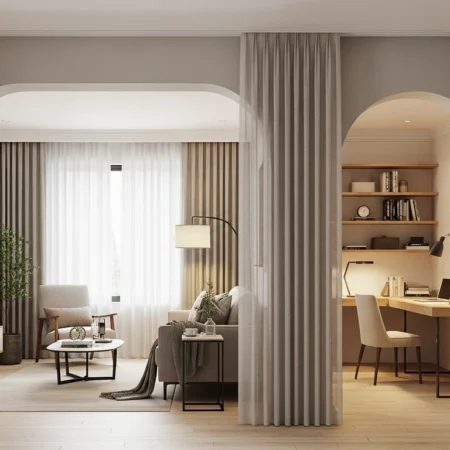Decorating a compact bedroom often feels like a puzzle where every square inch counts. You need privacy and style, but bulky floor-length drapes can quickly make a tiny space feel suffocated.
This is where shorter window treatments shine, offering a breezy alternative that frees up valuable wall space. They allow you to tuck a bed, desk, or radiator right under the sill without battling bunched-up fabric.
We’ve gathered stylish solutions that prove you don’t need yards of fabric to make a statement. From vintage-inspired cafe cuts to crisp modern shades, these looks will help you maximize both your view and your floor plan.
The Case for Short Curtains in Compact Spaces
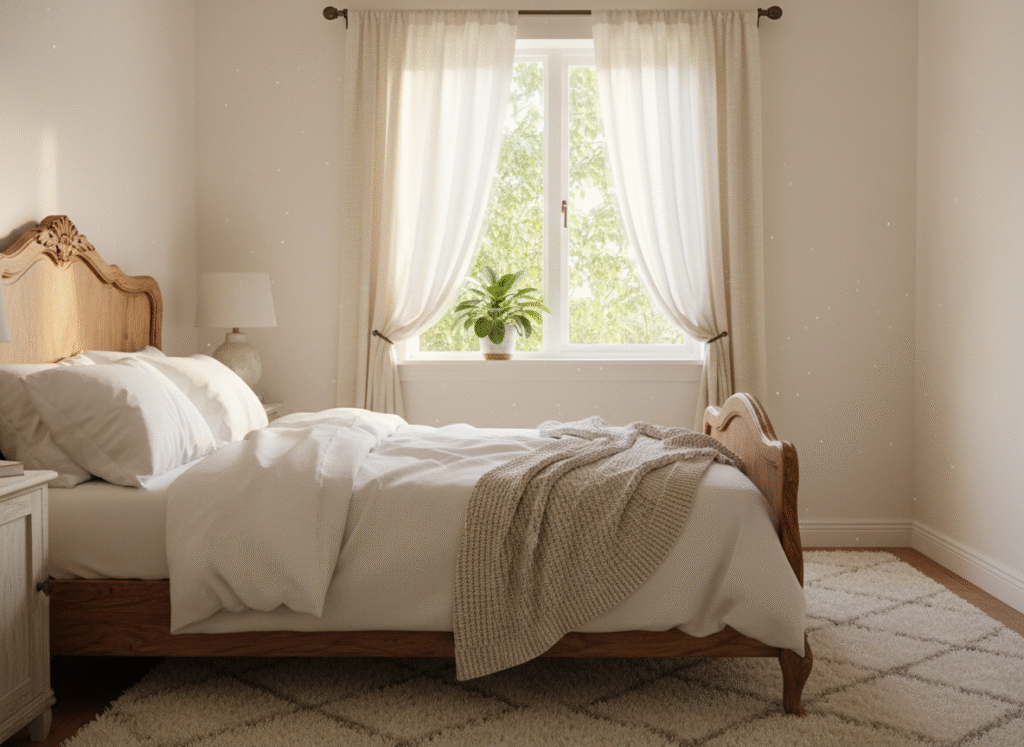
Standard design advice often screams “floor-to-ceiling” to maximize height. However, in a compact bedroom, yards of pooling fabric can quickly make the room feel claustrophobic.
Short curtains represent a strategic choice for maximizing usable square footage. By ending the treatment at the sill, you free up valuable wall space for essential furniture like a headboard, a desk, or a radiator. You no longer have to worry about blocking heat sources or crushing fabric behind a nightstand.
This approach also improves airflow and simplifies maintenance. You won’t have dust bunnies gathering in the hem, and the room instantly feels breezier and lighter.
To keep the look sophisticated, focus on texture over length. A high-quality linen or cotton weave catches the light beautifully, proving that you don’t need massive volume to make a stylish statement.
The Golden Rule of Length
Precision is key to pulling this off without it looking like a mistake. Your curtains should either just kiss the windowsill or hang exactly four to six inches below the apron.
Anything shorter looks accidental, while the correct drop feels custom, intentional, and undeniably cozy.
1. The Classic Cafe Curtain: Privacy Meets Light
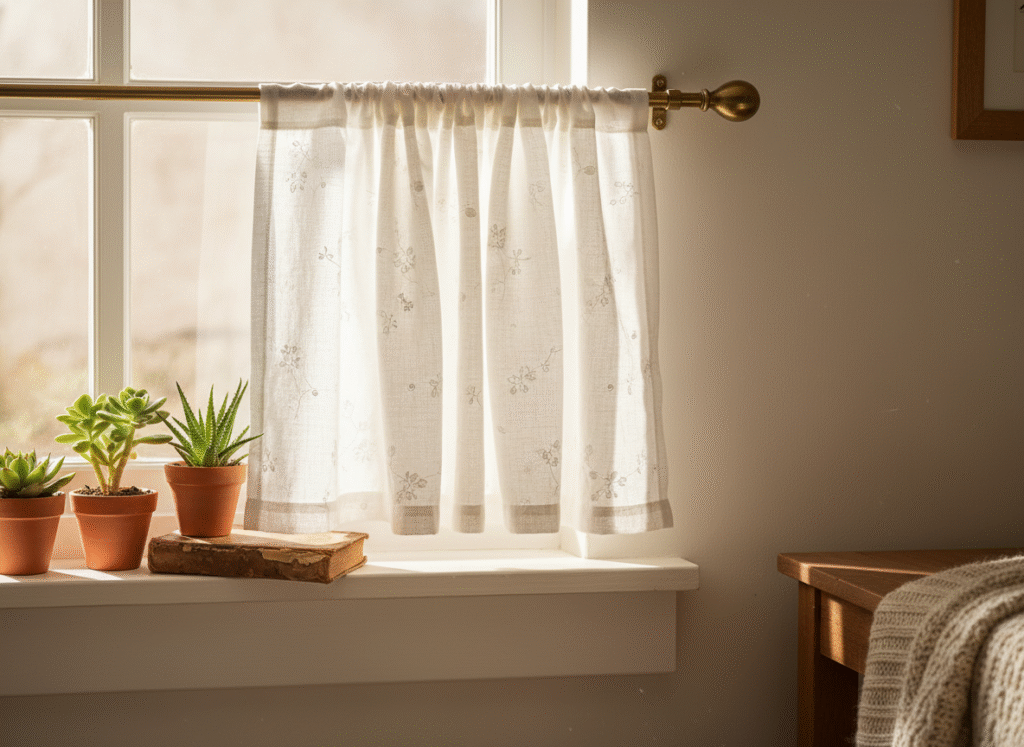
If you feel torn between blocking out neighbors and letting the sunshine in, cafe curtains are your best friend. By covering just the bottom half of the window, you secure privacy at eye level without turning your bedroom into a dark cave. This is the ultimate compromise for ground-floor rooms or apartments facing the street.
This style minimizes visual weight, which is crucial when square footage is limited. Full-length drapes can sometimes overwhelm a small wall, but a short cafe curtain feels breezy and intentional. Opt for lightweight cotton or linen to maintain that airy, crisp aesthetic.
Maximizing the Ledge
Since the fabric doesn’t bunch up at the bottom, you reclaim your windowsill as functional real estate. It becomes the perfect stage for sun-loving plants or a small stack of books. This adds a layer of décor that feels cozy rather than cluttered.
Installation is incredibly simple, often requiring just a tension rod inside the frame. Mount the rod halfway down or at the sash line to keep the proportions balanced and the natural light pouring in from above.
2. Structured Elegance with Roman Shades

If you prefer a tailored look over flowy fabric, Roman shades are the perfect solution. They offer a crisp alternative to traditional drapery that can sometimes overwhelm a compact space.
Unlike curtains that billow out, these shades sit flat against the glass to keep your wall space uncluttered. When raised, the fabric stacks into neat horizontal pleats that add just enough architectural interest.
This structure creates a sense of order, which is vital in small bedrooms where visual clutter feels magnified. You get the warmth and texture of fabric without the heavy bulk of floor-length panels.
Maximizing Your Space
Consider an inside mount if your window frames have attractive molding you want to show off. This tucks the shade neatly within the frame for a flush, custom-fitted appearance.
Alternatively, an outside mount installed a few inches above the frame can trick the eye. This technique makes a small window appear taller and lets in more natural light when the shade is fully raised.
For better sleep, ensure you choose a shade with a thermal or blackout lining. This blocks early morning sun and insulates drafty glass without changing the room’s aesthetic.
3. Relaxed Romance: Sheer Tie-Up Shades
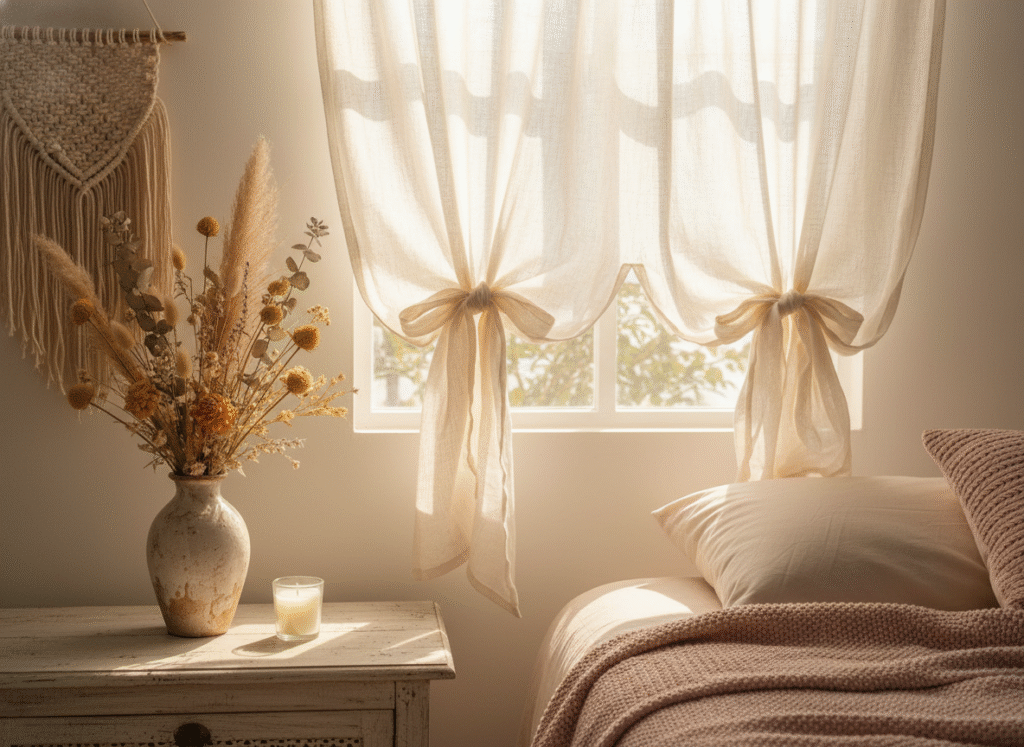
If you want to soften the hard edges of a small window, tie-up shades are a charming solution. They replace rigid lines with effortless drapes and curves, making them perfect for bohemian or cottage-style bedrooms.
Instead of a mechanical roller, these shades use ribbons or fabric strips to hold the material at your desired height. This creates a loose, scalloped fold at the bottom that feels casual yet elegant. It adds instant texture to a plain wall without overwhelming a small space.
Choosing a sheer, gauzy material transforms harsh sunlight into a soft, ambient glow. You get enough light filtration to keep the room bright, but enough coverage to maintain basic privacy.
Practical Consideration
Keep in mind that adjusting these requires manually re-tying the bows. Because of this, they are best suited for windows where you intend to leave the shade at a fixed height rather than raising and lowering it daily.
This is also one of the easiest window treatments to DIY. You essentially just need a hemmed piece of fabric and two long ribbons, meaning no complex sewing skills are required to get the look.
4. The Apron Length: A Tailored Finish
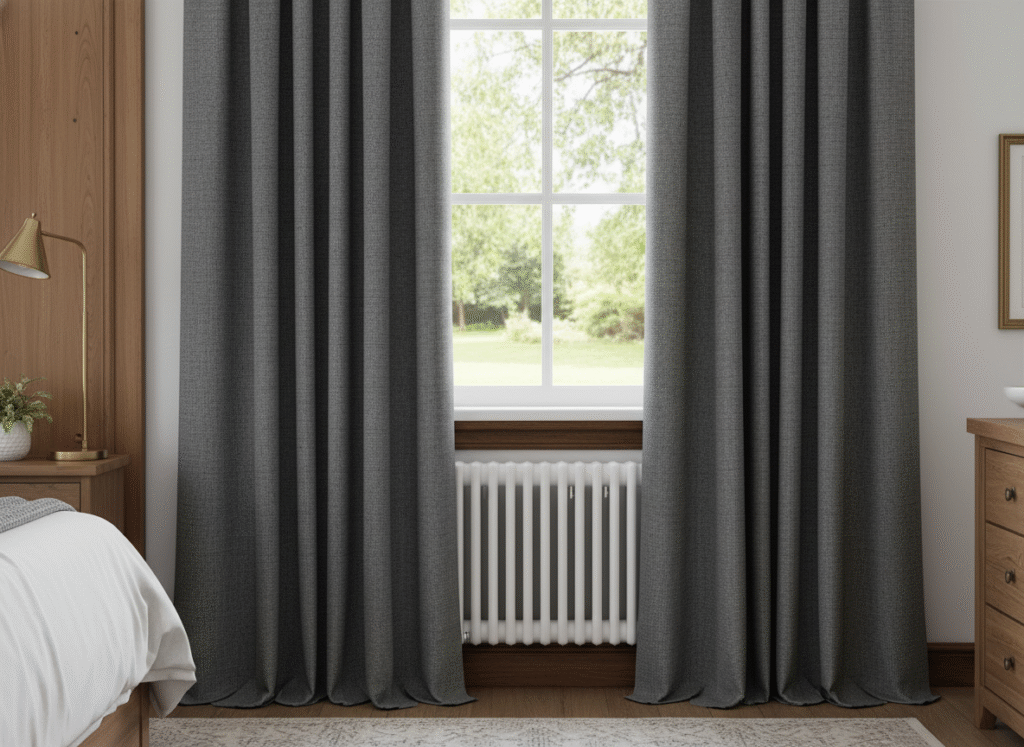
If sill-length feels a bit too abrupt but floor-length is impractical, the apron length is your perfect middle ground. These curtains extend roughly four inches below the window sill, effectively covering the wooden trim (the apron) underneath. It creates a tailored, custom appearance that looks much more expensive than it actually is.
This style is an absolute lifesaver if you have a radiator or baseboard heater directly beneath the window. Floor-length drapes would trap heat or create safety hazards, but apron length allows warm air to circulate freely into the room. It also frees up wall space, letting you tuck a headboard or desk tightly against the wall without bunching up fabric.
To make this look intentional rather than accidental, fabric choice is key. Opt for a material with some weight, like a textured weave or heavy cotton, which will hang straight down without flaring out.
Getting the Measurement Right
Precision is everything with this look. Measure from your curtain rod down to a point four to six inches past the window sill. The goal is to completely hide the window casing and apron trim while stopping well above the floor or skirting board.
5. Adding Character with Bold Prints and Valances
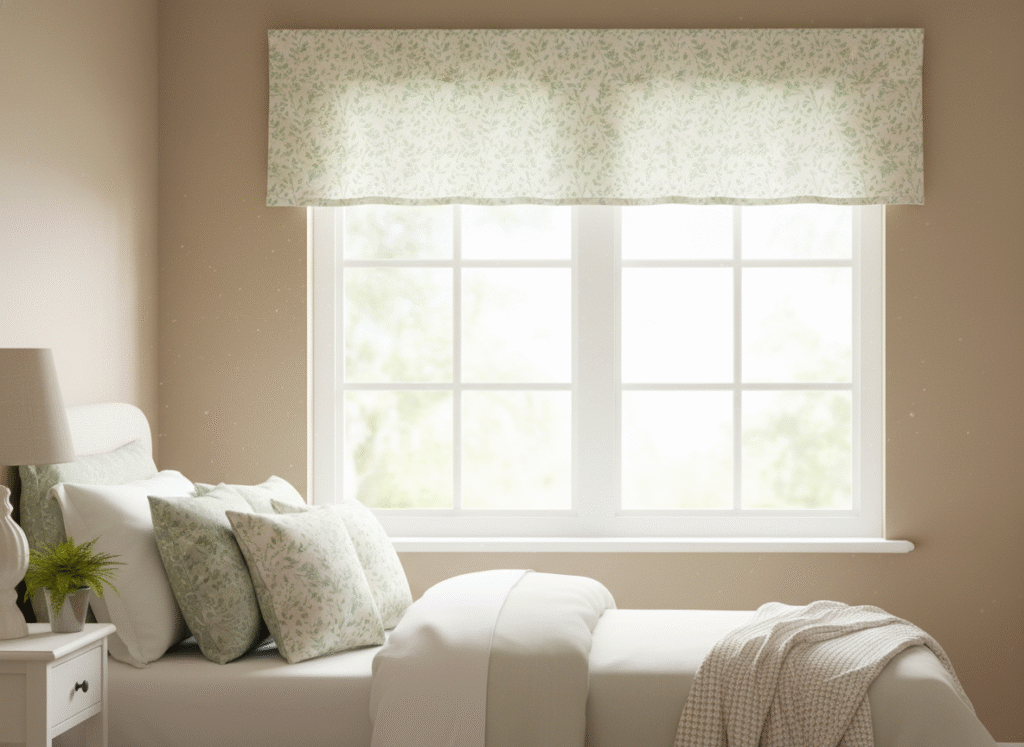
Small bedrooms often rely on plain white curtains to keep things “airy,” but that can sometimes feel a bit sterile. A short window is actually the perfect canvas for a bold print because it doesn’t dominate the room like floor-to-length drapes would.
Pairing short side panels with a matching valance creates a tailored, finished look that feels intentional. This setup frames your view beautifully, essentially turning your window into a piece of wall art.
To keep the space feeling calm, let the fabric be the star. Stick to neutral wall colors like cream or soft gray to allow the pattern to pop without creating visual clutter.
Why This Works for Small Rooms
- Hides Imperfections: A valance easily conceals clunky curtain rods or blinds pulled up at the top of the window.
- Adds Height: Mounting the valance a few inches above the window frame draws the eye up, making the ceiling feel higher.
- Controlled Color: You get a splash of personality without the commitment of painting the entire room.
Choosing the Right Pattern
In a compact room, the scale of your design is crucial. A small-scale botanical or subtle geometric print adds visual interest without making the walls feel like they are closing in.
6. Texture Play: Burlap and Linen Layers

Sometimes, a small room doesn’t need a loud print; it simply needs rich texture. Opting for rougher fabrics like burlap or heavyweight linen adds immediate visual weight and character to a compact space. This approach keeps the design feeling grounded and organic without shrinking the room.
These materials are exceptional for light filtration. Because of the visible weave and slight imperfections, sunlight pushes through to create a soft, warm glow rather than a harsh glare. It instantly makes a bedroom feel lived-in and cozy, perfect for lazy mornings.
Since these fabrics are naturally casual, the hardware you choose is critical for balance. Use matte black clip rings or a sleek iron rod to introduce a modern, industrial edge. This contrast prevents the window from looking too “crafty” and elevates the farmhouse aesthetic.
Softening the Look
Authentic burlap can be quite stiff and may shed fibers over time. If you love the visual but dislike the rough feel, search for “faux burlap” or a heavy textural linen blend. These alternatives provide that desired rustic weave but drape much softer against the window frame, giving you a more relaxed fold.
7. Modern Minimalist: Inside-Mount Roller Blinds

Sometimes, the best curtain idea isn’t a traditional curtain at all. For a truly modern, uncluttered aesthetic, inside-mount roller blinds are the gold standard. They fit snugly within the window casing, leaving the surrounding walls completely bare and open.
This is a massive advantage in a small bedroom where visual clutter makes the space feel cramped. By eliminating bulky curtain rods and billowing fabric, you instantly make the room feel larger and airier. When the blind is rolled up, it practically disappears, allowing maximum natural light to flood the space.
However, precision is key for this look. You need a deep window sill to pull this off successfully. If your frame is too shallow, the mechanism will protrude into the room, ruining that seamless, flush finish.
Choosing the Right Material
For a bedroom setting, prioritize a blackout fabric in a matte finish. This provides the sleep functionality you need without the visual weight of heavy drapes.
If you need versatility, consider a double roller system. This clever setup houses both a sheer screen for daytime privacy and a blackout layer for night, all tucked neatly inside the frame.
8. Boho Vibes with Macrame and Beading

If you want to steer away from traditional fabric, macrame offers a stunning textural alternative. The intricate knotting adds depth to a small room without making it feel closed in. It’s the ultimate choice for a relaxed, free-spirited aesthetic.
Because of the open weave, these coverings filter sunlight into beautiful patterns rather than blocking it out completely. This makes them ideal for windows where you want privacy but still crave natural light. You get a screen effect that blurs the view from outside while keeping the interior bright.
The heavy cotton cord used in macrame also adds a sense of warmth and coziness. It pairs exceptionally well with trailing houseplants and natural wood furniture to complete the look.
Choosing Your Weave
Not all macrame is created equal, so pay attention to the knot density based on your needs.
- Open Knots: Best for maximum light and a decorative frame effect.
- Tight Weaves: Better for obscuring the view into your bedroom for higher privacy.
- Embellishments: Look for designs with wooden beads or dyed fringe to add extra character and color.
Comparison Guide: Sill Length vs. Apron Length

Getting the length right is the secret to making short curtains look custom rather than accidental. You generally have two standard “short” options: hitting the sill or covering the apron.
Sill length curtains stop precisely at the windowsill, hovering just above the surface. This is the smart choice if you have a headboard, desk, or deep shelf pushed directly against the wall. It keeps the fabric from bunching up or getting trapped behind furniture.
Apron length extends about 4 to 6 inches lower to cover the wood trim beneath the sill. This creates a more polished look and helps elongate the appearance of the window. It is also far better at blocking light leaks at the bottom, which is a major plus for bedrooms.
The Rule of Thumb
Look at the wall space immediately below the window to make your final decision. If the wall is empty, go with the apron length for a softer, more elegant finish. However, if you have a radiator or heater vent there, stick to sill length to ensure safety and proper heat circulation.
Visual Tricks – Rod Placement Guide

Even if your curtains are short, your window doesn’t have to look tiny. The secret to elevating the look of a small bedroom lies entirely in hardware placement. By ignoring the actual edges of the window frame, you can create a powerful optical illusion that changes the scale of the room.
Go High for Height
Avoid mounting the rod directly on the window trim, which can make the space feel boxy. Instead, install your brackets 4 to 6 inches above the frame, or even halfway to the ceiling if space permits. This simple adjustment draws the eye upward, instantly making your ceilings feel taller and the room airier.
Go Wide for Light
Don’t let the curtains cover the glass when they are open. Extend your rod 3 to 6 inches beyond the sides of the window frame. This allows the fabric stack to rest against the wall rather than blocking the view. You get maximum natural light, and the window itself appears significantly wider than it actually is.
Conclusion
Choosing the right window treatment is about balancing style with the unique constraints of a smaller room. Whether you opt for airy sheer cafes or structured roman shades, short curtains prove that you don’t need floor-length fabric to make a big impact.
Don’t be afraid to experiment with bold patterns or textures that truly reflect your personality. Even the smallest window offers a massive opportunity to turn your bedroom into a cozy retreat that feels entirely your own.

